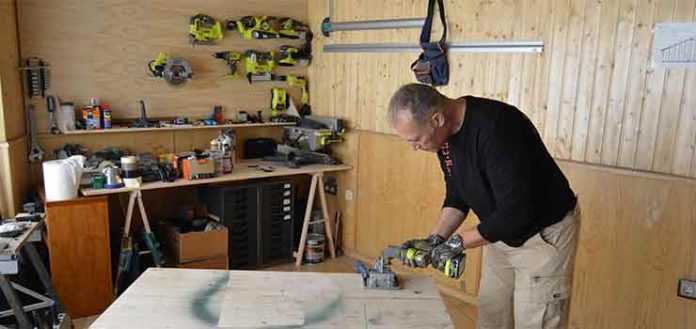
The oscillating multi-tool is a valuable ally for DIY jobs that require precision and, moreover, may be inaccessible to most tools.
As I already anticipated at the end of my previous article dedicated to power tools, in which we saw in depth Ryobi’s 18V Cordless Drill Driver, the Oscillating Multi-Tool is the great unknown. Being one of the reasons for this, its relatively recent introduction in the market and, specifically, in the DIY sector.
This power tool is available with cable, that is, it is connected directly to the electrical network. Or also, there are battery-powered. If you opt for this last option and you are going to use it frequently and for moderately hard work, I recommend that the power of the batteries is not less than 18 volts. The 18V battery that it incorporates gives you total freedom and autonomy.
In fact, for this article we tested the Ryobi 18V Multi-Tool, and it performed exceptionally well. If you watch the video included in this article, you can get an idea of the power of this tool.
It is a small tool, very light, and super versatile, thanks to the enormous variety of blades and accessories that can be purchased.
How does the multitool work?
The mechanical principle of the multi-tool, whether corded or battery-powered, is based on very slight oscillating movements, of about 3 degrees, as well as very fast, over 20,000 movements per minute. That is why this movement is perceived more as a vibration, than as such a movement of going well.
It is precisely this movement that allows it to perform functions as varied as sawing materials as diverse as wood, plastics and PVC, steel, masonry, ceramic materials and practically any type of material. It also works perfectly as a plunge saw, orbital sander, grinder, scraper, putty knife, etc.
It is not a tool to deal with medium or large-scale projects. Its enormous value lies in being able to perform an enormous diversity of functions.
Increasingly, they are the brands that incorporate speed preselection. In this way, the tool can be optimally adapted for various tasks. However, Ryobi, like some other brands, goes further. The speed regulation is integrated, electronically, in the activation trigger. The higher the pressure, the higher the speed, and vice versa.
The multitool that we are testing incorporates an LED light, which keeps the work area properly illuminated at all times.
Its use is extremely simple. Simply mount the accessory and activate it.
Although there are some models that incorporate a quick and tool-free accessory change system, the most common is that this process is carried out with an allen key, loosening and tightening a simple screw.
At this point, attention must be drawn to avoid accidents. The accessories must be assembled with the machine disconnected from the current, if it is electric, or otherwise, with the battery removed.
Accessories for the multi-tool
Below we include a table with a minimum part of the accessories that can be found on the market, with an indication of the applications indicated for each one of them.
The anchoring system of the different accessories is usually universal. Therefore, they are valid for most makes and models. However, before you buy one, you should make sure that it is compatible with your multitool.
Uses of the multitool
Contrary to popular belief, the multi-tool doesn’t just cut wood and soft materials. But it also does it with hard materials such as steel or tile. We just have to choose the right accessory.
As I have indicated before, it performs a multitude of functions on a wide variety of materials.
Likewise, it manages to make completely flush cuts. Something that, for example with a jigsaw, is materially impossible.
After the drill, the quintessential “king of DIY”, the multi-tool should have a very prominent place among the tools of any DIY enthusiast.
In the video that we include below, you will be able to see the tests that we have carried out on different materials such as…
Wood cuts. In addition to simple cuts, even pockets can be made.
Cut plasterboard.
Cuts on small pieces of steel and aluminum.
cut the PVC or other types of rigid plastics.
Cuts on tiles.
Grinding of tile jointsfor example, to replace grout in poor condition with another.
sanding of various materials, such as wood.
Video of the tests carried out
Below you can see, in just six minutes, all the tests indicated in the previous point.
What you have just seen is just the tip of the iceberg, since there are countless accessories and, therefore, countless applications.
I think the enormous versatility of this little tool has become clear.
Surely you have noticed that the multitool does not have a support base, so you always have to work freehand. However, once you get the hang of it, it’s very easy and comfortable to operate, even with one hand.
Where to buy it and how much does it cost?
You can find the Ryobi 18V Battery Multi-Tool at any repair center. bauhausalso in Leroy Merlinas well as in the marketplace of amazon.
Below are the links to both the multi-tool, and an accessory pack similar to the one we used in the video, as well as other items from the Ryobi One+ range, in case you want to buy it or just take a look. To do this, you just have to click on the following images:
.
next article power tools
Finally, let me tell you that in the next video dedicated to Ryobi DIY power tools, we will analyze the 18V battery stapler.
But make no mistake, this is not a tiny stapler. I will only advance you that the staples it uses are the same as those of the pneumatic staplers.
Stay tuned and don’t miss it!!
.



